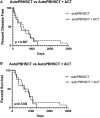A Retrospective Analysis: Autologous Peripheral Blood Hematopoietic Stem Cell Transplant Combined With Adoptive T-Cell Therapy for the Treatment of High-Grade B-Cell Lymphoma in Ten Dogs
- PMID: 34950726
- PMCID: PMC8688351
- DOI: 10.3389/fvets.2021.787373
A Retrospective Analysis: Autologous Peripheral Blood Hematopoietic Stem Cell Transplant Combined With Adoptive T-Cell Therapy for the Treatment of High-Grade B-Cell Lymphoma in Ten Dogs
Abstract
In humans, a type of cellular immunotherapy, called adoptive T cell transfer (ACT), can elicit curative responses against hematological malignancies and melanoma. ACT using ex vivo expanded peripheral blood T-cells after multiagent chemotherapy enhances tumor-free survival of dogs with B-cell lymphoma (LSA). Since 2008, our group has been performing autologous peripheral blood hematopoietic stem cell transplants (autoPBHSCT) for the treatment of canine high-grade B-cell LSA, although relapse of residual disease is a common cause of reduced survival in ~70% of treated dogs. We reasoned that a more aggressive treatment protocol combining CHOP (cyclophosphamide, doxorubicin, vincristine, prednisone) chemotherapy, autoPBHSCT, and ACT to treat 10 dogs with B-cell LSA could lead to better outcomes when compared to dogs treated with CHOP chemotherapy and autoPBHSCT alone. Using this protocol, once dogs achieved complete hematologic reconstitution post-autoPBHSCT, CD3+ CD8+ and CD3+CD4+ T-cells were expanded from the peripheral blood at a commercial laboratory. Two to four ACT infusions were given to each dog, with a total of 23 infusions given. Infusions were administered with no complications or adverse events. The median cell dose for all infusions was 5.62 x 106 cells/kg (range: 2.59 x 106-8.55 x 106 cells/kg). 4/10 (40%) of dogs were cured of their disease (defined as disease-free for ≥2 years post-autoPBHSCT). Our results confirm that the autoPBHSCT protocol did not hinder the in vitro expansion of autologous peripheral blood T-cells and that the final product could be administered safely, with no adverse events recorded. Finally, since only ten dogs were treated, our results can only suggest that the administration of ACT to dogs after multiagent chemotherapy and autoPHSCT did not lead to a statistically significant increase in median disease-free interval and overall survival when compared to dogs who received CHOP chemotherapy and autoPHSCT alone.
Keywords: CHOP chemotherapy; adoptive T-Cell therapy; dogs; hematopoietic stem cell transplantation; lymphoma.
Copyright © 2021 Gareau, Ripoll and Suter.
Conflict of interest statement
The authors declare that the research was conducted in the absence of any commercial or financial relationships that could be construed as a potential conflict of interest.
Figures


References
LinkOut - more resources
Full Text Sources
Research Materials

